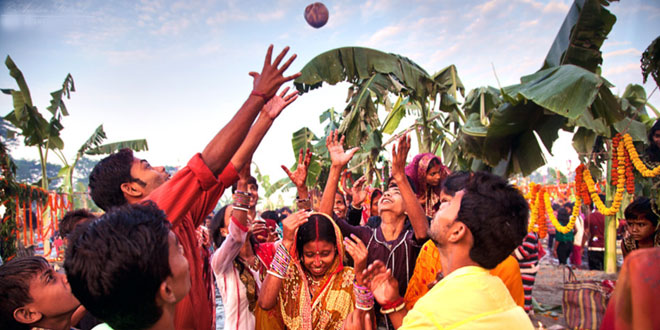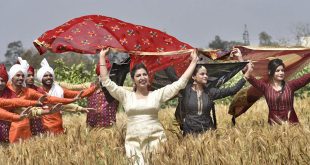Chhath Pooja Rituals In Hindu Culture: Almost immediately after the merriment of Diwali subsided, the solemnity of Chhath takes over. Adult married Hindu Indian women of the household make all the preparations that are required for the puja. While the younger women and children take over the everyday household chores, these women begin with a thorough spring-cleaning of all the things that would be used to prepare the prasad or food offerings to the Sun God. Everything, from the kitchen chulha to the ladles, cooking wok and frying pan is purified.
It is the bounty of the harvest, which is deemed a fit offering to the Sun god. Newly pounded rice is soaked and made into a paste. Dry fruits, nuts and slivers of coconut are used as flavoring and the cooked lump is then rolled in the palms, into hardened laddoos. Wheat flour becomes the main ingredient for the traditional cake called thekua. The dough is cut into shapes or pressed into wooden molds before they are fried a crisp deep brown, to be eaten as a crumbling mouthful. Generous amounts of clarified butter, oodles of jaggery and coconut shavings go into this equivalent of the cookie.
Chhath Pooja Rituals:
For the preparation of these offerings, the lady in command observes certain rules like abstaining from eating cooked meals and not wearing stitched clothes. A bath before entering the kitchen is a must for everyone.
By the time the day of the fast arrives, all the preparations are complete and a solemn atmosphere prevails. Accompanied by chorus renditions of traditional devotional songs, the procession, which begins as a small group at a doorstep, becomes a surging crowd of devotees as one nears the riverbanks. In the procession, bare-chested men carry the prasad in a basket of bamboo weaves. The basket is held high above the crowds’ hands for the fear of it being soiled by a chance impure touch. Within it are the laddoos, thekuas and of course the fruits of the season. Coconuts, a bunch of bananas, an orange or two and always an earthen lamp, covered with a cotton cloth, dyed in turmeric, are the unchangeable contents.
No one tells the hour of prayer but, almost magically, the procession is timed to accuracy and the prayers are offered at the moment the Sun sets. On the banks of the river, no one can afford to slip or falter, as that would mean an evil portent. As the western sky of early winter turns rosy, the scene is a concerted vision of devotion as countless up-stretched arms hold aloft the glistening bamboo trays and baskets. The veiled oil lamps are gently glowing and a chorus of hymns rings the air. Minutes pass, and the faces become blurred as the crowd begins the walk back, leading away from the riverfront.
Chhath Pooja Rituals: Having paid homage to the setting sun, the next day, one must make ready for the daybreak obeisance. This is the crucial part of the ritual and the journey towards the river begins when not even the slightest hint of sunlight is visible. It is a mahogany black sky outside as the festival falls during the dark phase of the moon. One can tell when the riverbank is near from the smell of dew soaked grass and lapping of water. This time the faces turn eastward and instead of just standing on the riverbank, the devotees enter the water for the customary holy dip. In the meantime, the baskets are left securely under a temporary canopy, made of freshly harvested sugar cane stalks. A four-sided platform is made especially for this with its corners decorated with terra cotta lamps shaped like elephants or birds. Sandalwood paste, vermilion, wet rice, flowers and fruits, covered over with red dyed cotton cloth, to ward off evil designs and spirits, add the right note of sanctity. Once the first streaks appear on the horizon, men and women, dressed in their saris and dhotis (loin cloth) plunge into the shallow waters. Having found a foothold and completely oblivious of the chilling waters, they begin the timeless mantra of the Rig Veda, specific to the Sun – the Gayatri Mantra.
 Kids Portal For Parents India Kids Network
Kids Portal For Parents India Kids Network







